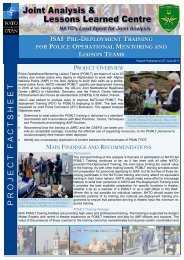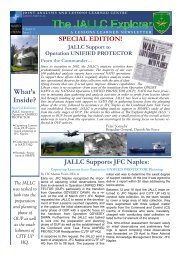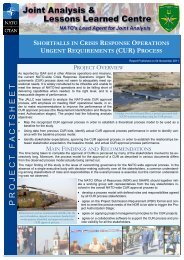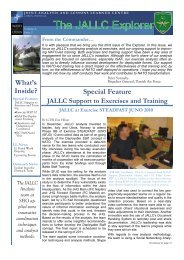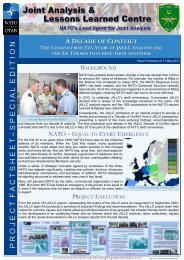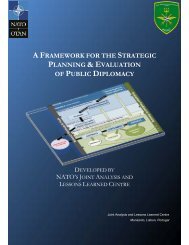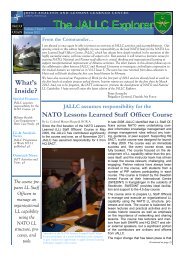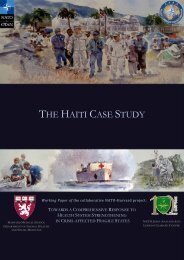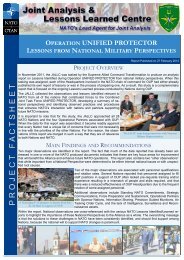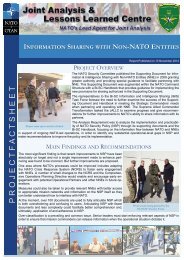Afghan m<strong>in</strong>isters visited the prov<strong>in</strong>ce. The objective of these visits was toopen a dialogue and to be personally <strong>in</strong>formed of problems at local level.Two other <strong>in</strong>itiatives <strong>in</strong> Uruzgan started at the same time as the IDLGprogramme. These were the Afghan Subnational Governance Programme(ASGP), <strong>in</strong> which the Independent Adm<strong>in</strong>istrative Reform & Civil ServiceCommission (CSC) was <strong>in</strong>volved, and the Priority Reform andReconstruction (PRR) programme. The objective of the two programmeswas to <strong>in</strong>crease the number of qualified civil servants operat<strong>in</strong>g at theprov<strong>in</strong>cial level. The <strong>Netherlands</strong> has urged the CSC to devote moreattention to the recruitment and tra<strong>in</strong><strong>in</strong>g of civil servants <strong>in</strong> Afghanistan. Asa consequence, <strong>in</strong> early <strong>2010</strong>, the CSC committed itself to strengthen<strong>in</strong>gprov<strong>in</strong>cial government <strong>in</strong> Uruzgan by provid<strong>in</strong>g more civil servants and,furthermore, fulfilled this pledge with Australian fund<strong>in</strong>g by establish<strong>in</strong>g aprogramme for capacity-build<strong>in</strong>g <strong>in</strong> Uruzgan. Fifty tra<strong>in</strong>ees were recruitedfor the programme and tra<strong>in</strong>ed for employment with the prov<strong>in</strong>cialgovernment. By the end of <strong>2010</strong>, 37 of these tra<strong>in</strong>ees were employed <strong>in</strong>prov<strong>in</strong>cial government.The activities of various NGOs and <strong>in</strong>ternational organisations (IOs) <strong>in</strong>Uruzgan also showed an <strong>in</strong>crease. The ASGP and UNDP and the open<strong>in</strong>g ofa UNAMA field office <strong>in</strong> the prov<strong>in</strong>ce are examples of this. The eventualestablishment of a UNAMA office <strong>in</strong> Uruzgan was a direct consequence ofDutch diplomatic efforts and resulted <strong>in</strong> the UN carry<strong>in</strong>g out variousdevelopment programmes <strong>in</strong> Uruzgan (‘food for work’, school mealprogrammes and vacc<strong>in</strong>ation programmes). Prior to the mission, there wereonly seven NGOs active <strong>in</strong> Uruzgan; <strong>in</strong> <strong>2010</strong>, the number of NGOs that wereor had been active <strong>in</strong> Uruzgan had <strong>in</strong>creased to over forty. This <strong>in</strong>creasewas partly the result of conscious Dutch efforts, on the diplomatic andsecurity fronts, to stimulate the civil doma<strong>in</strong> <strong>in</strong> the prov<strong>in</strong>ce.Among these activities, there were also <strong>in</strong>itiatives aimed at enhanc<strong>in</strong>g thecapacity and quality of local government. For example, the German NGOGesellschaft für Technische Zusammenarbeit (GTZ) provided tra<strong>in</strong><strong>in</strong>gcourses to government officials and The Asia Foundation (TAF) madeadvisers available to local governors with the aid of Dutch fund<strong>in</strong>g. Inaddition to TAF, the IDLG also employed a number of Afghan advisers <strong>in</strong>support of the Governor of Uruzgan. Dur<strong>in</strong>g the course of the mission, theGovernor appo<strong>in</strong>ted 20 advisers, but <strong>in</strong> practical terms these did not allexercise an equal amount of <strong>in</strong>fluence. This was due to the fact that theGovernor as well as the advisers had little budgetary and discretionaryauthority. This authority was vested <strong>in</strong> the prov<strong>in</strong>cial m<strong>in</strong>istries, whichoperated under directions from Kabul. For this reason, the Governor and hisadvisers could do relatively little about possibly dysfunctional m<strong>in</strong>istries. All<strong>in</strong> all, only a part of the advisers, particularly the advisers for security,<strong>in</strong>frastructure and rural development, had an <strong>in</strong>fluence on policy <strong>in</strong>Uruzgan.Various tra<strong>in</strong><strong>in</strong>g courses given on the subject of good governance haveresulted <strong>in</strong> more civil servants becom<strong>in</strong>g aware of its basic pr<strong>in</strong>ciples. Thesepr<strong>in</strong>ciples <strong>in</strong>clude the adm<strong>in</strong>istrative plann<strong>in</strong>g and budgetary cycle.At the national level, the <strong>Netherlands</strong> did not only request more focus onpoor governance <strong>in</strong> Uruzgan and on the fund<strong>in</strong>g of various programmesaimed at enhanc<strong>in</strong>g the effectiveness of local government, but also <strong>in</strong>vested<strong>in</strong> improv<strong>in</strong>g government build<strong>in</strong>gs and other civil service facilities. This wasa highly necessary step for develop<strong>in</strong>g governance. One example of thiswas the reopen<strong>in</strong>g of the White Compound, the seat of the districtPage 52 of 133
government of Chora <strong>in</strong> January <strong>2010</strong>, made possible by the renovation ofthe build<strong>in</strong>g with Dutch resources. This project contributed to mak<strong>in</strong>g thedistrict government better able to carry out its adm<strong>in</strong>istrative work.The visibility of government <strong>in</strong> Uruzgan <strong>in</strong> <strong>2010</strong> has improved s<strong>in</strong>ce <strong>2006</strong>.After decades of absence, district governments were set up <strong>in</strong> two districts(Deh Rawod and Chora) follow<strong>in</strong>g efforts made by the <strong>Netherlands</strong>. Thepopulation <strong>in</strong> these areas is once aga<strong>in</strong> <strong>in</strong>volved <strong>in</strong> politics, after a longabsence of formal government. This is a step <strong>in</strong> the right direction.Dur<strong>in</strong>g the course of the mission, the <strong>Netherlands</strong> cont<strong>in</strong>uously advocated,both at the national and <strong>in</strong>ternational levels (e.g. dur<strong>in</strong>g various<strong>in</strong>ternational conferences on Afghanistan), a broad, national capacitybuild<strong>in</strong>gprogramme. In June <strong>2010</strong>, the Afghan government approved theSub-National Governance Policy Framework on the basis of agreementsmade dur<strong>in</strong>g the London conference. This acted as the new Afghan nationalpolicy framework for the improvement of local government, with subframeworksfor f<strong>in</strong>ancial management, capacity development and tackl<strong>in</strong>gcorruption.Sub-conclusion on capacity-build<strong>in</strong>g:Despite all of the <strong>in</strong>itiatives taken, capacity-build<strong>in</strong>g <strong>in</strong> the area ofgovernance was laborious. The figures show moderate progress <strong>in</strong> thequantitative capacity of formal local governance; from 20% to 30% <strong>in</strong>terms of staff<strong>in</strong>g, as the TLO report states. Although, by the end of themission, the positions of governor and chief-of-police were manned <strong>in</strong> alldistricts, a large proportion of the other positions rema<strong>in</strong>ed vacant. Thismeans that by late <strong>2010</strong>, capacity shortfalls were still among the biggestproblems for the development of good governance.4.4.2 Transparency and <strong>in</strong>tegrityIn addition to capacity-build<strong>in</strong>g, one of the policy priorities <strong>in</strong> place was toenhance the legitimacy of local government by improv<strong>in</strong>g transparency and<strong>in</strong>tegrity. At the start of the mission, government organisations did nothave a great deal of legitimacy among the local population. Variousproblems, among them the dom<strong>in</strong>ance of the Popolzai tribe <strong>in</strong> localgovernment positions, played a part <strong>in</strong> this phenomenon. In addition,appo<strong>in</strong>tments were almost always based on personal relations with highplacedprov<strong>in</strong>cial or national government officials or even the President,<strong>in</strong>stead of on qualifications for the job. Large-scale corruption with<strong>in</strong>prov<strong>in</strong>cial government and failure to apply f<strong>in</strong>ancial control mechanismswere further problems <strong>in</strong> this area.The 2007 Article 100 letter announced the <strong>in</strong>tensification of Dutch policyregard<strong>in</strong>g the support and mentor<strong>in</strong>g of local governance <strong>in</strong> Uruzgan.Increas<strong>in</strong>g the transparency and <strong>in</strong>tegrity of local governance was meant to<strong>in</strong>crease the population’s confidence <strong>in</strong> local government organisations, <strong>in</strong>turn result<strong>in</strong>g <strong>in</strong> acceptance and greater effectiveness of theseorganisations. At national level, the <strong>Netherlands</strong> pressed for theappo<strong>in</strong>tment of government officials known for their personal <strong>in</strong>tegrity.In the context of transparency and <strong>in</strong>tegrity, the <strong>Netherlands</strong> alsoadvocated a policy of appo<strong>in</strong>t<strong>in</strong>g suitable candidates for jobs. As part of the<strong>Netherlands</strong>’ efforts <strong>in</strong> this field, the <strong>Netherlands</strong> lobbied for prov<strong>in</strong>cial civilservants who did not belong to the Popolzai tribe and were of goodreputation. On a number of occasions, the Dutch lobby met with success.For example, Jan Mohammed Khan resigned before the Dutch missionbegan and a governor with a better reputation, Munib, was appo<strong>in</strong>ted toPage 53 of 133
- Page 1 and 2: Final evaluationNetherlands contrib
- Page 3 and 4: High mountainsLow mountainsPlains a
- Page 5 and 6: Table of ContentsDutch military per
- Page 7 and 8: Dutch military personnel deceased i
- Page 9 and 10: Page 9 of 133
- Page 11 and 12: 1 IntroductionThe government would,
- Page 13 and 14: The structure of the final evaluati
- Page 15 and 16: 2 The international presence in Afg
- Page 17 and 18: insurgents in, particularly, the ea
- Page 19 and 20: 3 Netherlands policy for participat
- Page 21 and 22: Netherlands’ presence. Furthermor
- Page 23 and 24: “The objectives of this stabilisa
- Page 25 and 26: In December 2005, the Netherlands g
- Page 27 and 28: The expectation is that meaningful
- Page 29 and 30: 3.6.2 Implementation of national pr
- Page 31 and 32: 4 Implementation of the mission and
- Page 33 and 34: tasks to fulfil in the area of secu
- Page 35 and 36: such as the Bushmaster, that was be
- Page 37 and 38: Afghan partner unit, at all times o
- Page 39 and 40: northern part of Deh Rawod in 2007.
- Page 41 and 42: in large and small bases, while con
- Page 43 and 44: previously thought and comprised a
- Page 45 and 46: Apart from facilitating training an
- Page 47 and 48: If operations in close proximity of
- Page 49 and 50: As previously mentioned, the preven
- Page 51: - Between 2006 and 2010, the number
- Page 55 and 56: At the beginning of the Dutch missi
- Page 57 and 58: intermediary of TLO and political a
- Page 59 and 60: interest for filling judicial posit
- Page 61 and 62: During the Uruzgan mission, a great
- Page 63 and 64: structurally change governance in U
- Page 65 and 66: development programmes. Before the
- Page 67 and 68: also the way in which Afghans perce
- Page 69 and 70: tailored to the real needs of the p
- Page 71 and 72: Gizab had increased and there was a
- Page 73 and 74: The DCU programme devoted and still
- Page 75 and 76: purpose of these loans, cooperative
- Page 77 and 78: In view of the lack of enthusiasm a
- Page 79 and 80: 5 Expenditure for the mission and i
- Page 81 and 82: Overview of long-term expenditure a
- Page 83 and 84: expenditure related to the deployme
- Page 85 and 86: Multi-year expenditure, Foreign Aff
- Page 87 and 88: explosive ordnance disposal, armour
- Page 89 and 90: this situation as constraining, for
- Page 91 and 92: organised at a later stage. In addi
- Page 93 and 94: occupational social workers and the
- Page 95 and 96: Mercedes Benz terrain vehicle, the
- Page 97 and 98: 6 ConclusionsThis chapter begins wi
- Page 99 and 100: The first part of the central quest
- Page 101 and 102: At the end of 2005, the Afghan auth
- Page 103 and 104:
province. This, too, was done by me
- Page 105 and 106:
area, increased sales of agricultur
- Page 107 and 108:
ISAF and the OEF led to extra coord
- Page 109 and 110:
d. The recommendations from advisor
- Page 111 and 112:
Page 111 of 133
- Page 113 and 114:
Annex A, Afghanistan Compact Benchm
- Page 115 and 116:
end-2010, reforms will strengthen t
- Page 117 and 118:
Afghan Cultural HeritageA comprehen
- Page 119 and 120:
Private Sector Development and Trad
- Page 121 and 122:
Annex B, Results of the socio-econo
- Page 123 and 124:
EducationTLO data:• In 2006 there
- Page 125 and 126:
Overview of the number of children
- Page 127 and 128:
Annex C, Chronology200522 December:
- Page 129 and 130:
July: microcredit provider World Co
- Page 131 and 132:
Annex D, List of abbreviations3DADZ
- Page 133:
Page 133 of 133




